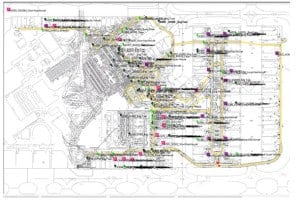
AiQ strives to produce tools and simulations that give maximum benefits to clients. Providing integrated, simple and effective analysis and simulations allows us to advise and present our clients with the information they need to run operational and cost effective airports.
In addition to all of the integrated operational Capacity Planning tools (Chk-in, MUP, Arrival, Stand Planning) offered by AiQ, we have now developed our own discrete Apron Vehicle simulation.
As part of TranvisionAiR, it gives the following benefits to clients:
- Integration of Schedule, Passenger, Baggage and Vehicle data. Other SIMS focus on specific data sources and make crude assumptions for others.
- Sat Nav (shortest Journey by Route Cost) and Job Optimised (i.e. BA RMS system) enabled
- Amongst other things, Apron Vehicle Simulations can derive the following information:
- Network Congestion (includes internal Baggage Hall areas)
- Journey Times (Freeflow & Network)
- ADPs
- Empty Can Storage profiles by Airline
- Full Can Storage profiles by Airline
- Vehicle Quantities and Usage
- Ramp & Baggage Staffing.
- Presentation of visual information in different Layers or views.
- We have developed it to be simple to set-up and better value than other Airport SIMs on the market.
- It is derived from 1st principles by Applied Engineering Physicists, and does not use any other SIM engine at its heart.
- As the developer, we can quickly adapt the Tools, Queries or Reports to suit the Client needs
These benefits provide maximum efficiency for the client, at minimal cost, whilst ensuring flexibility for future growth and capacity.
One example where our work within Apron Vehicle Simulations has paid dividends for the clients was Inter Terminal Passenger Coaching Operations at Heathrow . The client was facing a difficult challenge regarding the operations, as it was due for re-tender, and the client had no previous information about the service on which to base their criteria for judging new tenders. They were also facing a huge increase in operations in Terminal 3. AiQ were able to create a Stochastic model to understand the fluctuations and variations that surround a typical day’s activity at Heathrow, taking a season’s worth of Big Data.
The client expected to need a significant increase in demand but, by using Transvision AiR to provide Apron Vehicle Simulations, we were able to demonstrate that deploying coaches from previously under-utilised routes would improve the efficiency of the operation. Our Stochastic model, and the information derived from it, meant that the client was able to maintain the current size of the fleet despite the increase in flights, and keep within their Service Level Agreements.
This integration of information, the presentation and flexibility of the tool allows our clients to use data effectively and efficiently to make the right decisions for their airports, saving costs, maximising passenger satisfaction.
To find out more about our work within Apron, read our case studies or contact us today.

